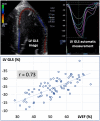Could strain echocardiography help to assess systolic function in critically ill COVID-19 patients?
- PMID: 33638061
- PMCID: PMC7910195
- DOI: 10.1007/s10877-021-00677-1
Could strain echocardiography help to assess systolic function in critically ill COVID-19 patients?
Abstract
Strain echocardiography enables the automatic quantification of the global longitudinal strain (GLS), which is a direct measure of ventricular shortening during systole. In the current context of overwhelmed ICUs and clinician shortage, GLS has the advantage to be quick and easy to measure by non-experts. However, little is known regarding its value to assess bi-ventricular systolic function in critically ill COVID-19 patients. Therefore, we designed a study to compare right and left ventricular GLS with classic echo-Doppler indices of systolic function, namely the ejection fraction for the left ventricle (LVEF) and the fractional area change (FAC), the tricuspid annular plane systolic excursion (TAPSE), and the tissue Doppler velocity of the basal free lateral wall (S') for the right ventricle. Eighty transthoracic echocardiographic evaluations done in 30 ICU patients with COVID-19 were analyzed. We observed a fair relationship (r = 0.73, p < 0.01) between LVEF and left ventricular GLS. The GLS cut-off value of - 22% identified a LVEF < 50% with a sensitivity of 63% and a specificity of 80%. All patients with a GLS > - 17% had a LVEF < 50%. Although statistically significant, relationships between FAC (r = 0.41, p < 0.01), TAPSE (r = 0.26, p < 0.05) and right ventricular GLS were weak. S' was not correlated with right ventricular GLS. In conclusion, left ventricular GLS was useful to assess left ventricular systolic function. However, right ventricular GLS was poorly correlated with FAC, TAPSE and S'. Further studies are needed to clarify what is the best method to assess right ventricular systolic function in ICU patients with COVID-19.
Keywords: COVID-19; Echocardiography; Global longitudinal strain; Point-of-care ultrasound; Speckle tracking; Systolic function.
© 2021. The Author(s), under exclusive licence to Springer Nature B.V. part of Springer Nature.
Conflict of interest statement
FM is the founder and managing director of MiCo, a Swiss consulting and research firm. MiCo does not sell any medical products and FM does not own any shares from any MedTech company. FG, RG and JB have nothing to declare.
Figures


Similar articles
-
Echocardiographic predictors of intraoperative right ventricular dysfunction: a 2D and speckle tracking echocardiography study.Cardiovasc Ultrasound. 2019 Jun 7;17(1):11. doi: 10.1186/s12947-019-0161-3. Cardiovasc Ultrasound. 2019. PMID: 31174537 Free PMC article.
-
Usefulness of Right Ventricular Longitudinal Shortening Fraction to Detect Right Ventricular Dysfunction in Acute Cor Pulmonale Related to COVID-19.J Cardiothorac Vasc Anesth. 2021 Dec;35(12):3594-3603. doi: 10.1053/j.jvca.2021.01.025. Epub 2021 Jan 18. J Cardiothorac Vasc Anesth. 2021. PMID: 33558133 Free PMC article.
-
Traditional and innovative echocardiographic parameters for the analysis of right ventricular performance in comparison with cardiac magnetic resonance.Eur Heart J Cardiovasc Imaging. 2015 Jan;16(1):47-52. doi: 10.1093/ehjci/jeu156. Epub 2014 Sep 3. Eur Heart J Cardiovasc Imaging. 2015. PMID: 25187607
-
Echocardiographic evaluation of right ventricular systolic function: The traditional and innovative approach.Cardiol J. 2017;24(5):563-572. doi: 10.5603/CJ.a2017.0051. Epub 2017 May 12. Cardiol J. 2017. PMID: 28497844 Review.
-
Echocardiographic Assessment of Biventricular Mechanics in Patients with Mild-to-Moderate Idiopathic Pulmonary Fibrosis: A Systematic Review and Meta-Analysis.J Clin Med. 2025 Jan 22;14(3):714. doi: 10.3390/jcm14030714. J Clin Med. 2025. PMID: 39941384 Free PMC article. Review.
Cited by
-
AI for the hemodynamic assessment of critically ill and surgical patients: focus on clinical applications.Ann Intensive Care. 2025 Feb 24;15(1):26. doi: 10.1186/s13613-025-01448-w. Ann Intensive Care. 2025. PMID: 39992575 Free PMC article. Review.
-
Visualizing hemodynamics: innovative graphical displays and imaging techniques in anesthesia and critical care.Crit Care. 2025 Jan 3;29(1):3. doi: 10.1186/s13054-024-05239-w. Crit Care. 2025. PMID: 39754204 Free PMC article. Review.
-
Past and Present of Point-of-Care Ultrasound (PoCUS): A Narrative Review.Cureus. 2023 Dec 8;15(12):e50155. doi: 10.7759/cureus.50155. eCollection 2023 Dec. Cureus. 2023. PMID: 38192958 Free PMC article. Review.
-
Characteristic Immune Dynamics in COVID-19 Patients with Cardiac Dysfunction.J Clin Med. 2022 Mar 28;11(7):1880. doi: 10.3390/jcm11071880. J Clin Med. 2022. PMID: 35407485 Free PMC article.
-
Abnormal Echocardiographic Findings in Hospitalized Patients with Covid-19: A Systematic Review and Meta-analysis.Arq Bras Cardiol. 2022 Aug;119(2):267-279. doi: 10.36660/abc.20210485. Arq Bras Cardiol. 2022. PMID: 35830075 Free PMC article. English, Portuguese.
References
-
- Lu KJ, Chen JXC, Profitis K, et al. Right ventricular global longitudinal strain is an independent predictor of right ventricular function: a multimodality study of cardiac magnetic resonance imaging, real time three-dimensional echocardiography and speckle tracking echocardiography. Echocardiography. 2015;32:966–974. doi: 10.1111/echo.12783. - DOI - PubMed
-
- Sanfilippo F, Corredor C, Fletcher N, et al. Left ventricular systolic function evaluated by strain echocardiography and relationship with mortality in patients with severe sepsis or septic shock: a systematic review and meta-analysis. Crit Care. 2018;22:183. doi: 10.1186/s13054-018-2113-y. - DOI - PMC - PubMed
Publication types
MeSH terms
Grants and funding
LinkOut - more resources
Full Text Sources
Other Literature Sources
Medical
Miscellaneous

